What is Rosacea?
Rosacea is a chronic skin condition that causes redness and inflammation of the skin. It can affect any age group but it is more common in fair-skinned people with freckles and light hair or those who have a family history of rosacea. The name rosacea comes from the Latin word “rosa” which means “pink.”
415 million people are affected By Rosacea Worldwide. It affects both men and women but research shows that women are more likely to develop rosacea. Men are more likely to have it on their neck, ears, or scalp while women are more likely to have it on their cheeks. Although they tend to experience various symptoms of rosacea it’s important to note that the consequences of ignoring your rosacea symptoms can be just as damaging to both sexes.
Rosacea usually starts with redness and may then progress to small blood vessels becoming visible on the surface of the skin (telangiectasias), pimples (papules), or pus-filled spots (pustules). These symptoms may be triggered by different factors such as sun exposure, alcohol consumption, or hot weather.
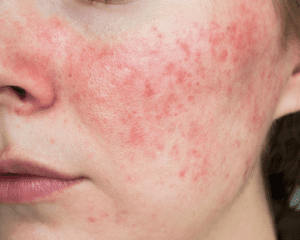
What are the Symptoms of Rosacea?
Rosacea is a skin condition that causes redness and inflammation on the face. It is thought that rosacea develops as a result of increased blood flow to the skin’s surface. Typically starting with a burning or stinging sensation in your cheeks or nose that gradually spreads across your face to other areas like your forehead or chin. It can also affect the neck, chest, ears, and scalp.
Symptoms of rosacea:
- Redness of the skin
- Flushing or blushing
- Skin bumps called papules
- Visible blood vessels
- Burning or stinging sensation
- Skin dryness
- Puffy or swollen skin
- Rough patches on your skin
- Swelling on the nose, cheeks, or eyes
- Eyes may be bloodshot and feel dry or gritty
- Watery or red eyes
- Swollen nose tip (may be mistaken for an allergic reaction)
- Enlarged nose (rhinophyma)
- Thinning skin
- Thickening of the skin on your nose or forehead
- Migraines and headaches
- Sensitive skin that may burn easily from sunlight or other types of exposure
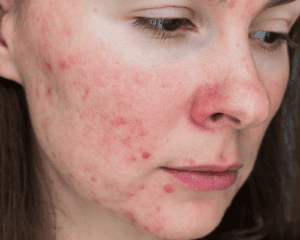
What Causes Rosacea?
The cause of rosacea is still not well understood. One theory is that it could be caused by an overactive immune system, which leads to inflammation in the body. Another possible cause is microorganisms on the skin (such as bacteria or yeast).
A person’s risk of developing rosacea increases with age, and women are more likely than men to develop rosacea. Some people also believe that rosacea may be linked to an allergy to certain foods such as hot peppers, tomatoes, and alcohol.
There are many factors that may contribute to the cause of rosacea, including:
- Family history of rosacea
- Skin sensitivity
- Overactive immune system
- Environmental conditions
- Aging
- Poor diet
- Reaction to cosmetics
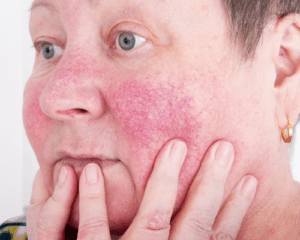
How to Treat Rosacea
Rosacea is a chronic condition, so it will require ongoing treatment to keep symptoms under control. The best treatments for rosacea vary depending on the severity of your symptoms and what you’re comfortable with trying.
Mild cases can be treated with topical medication like antibiotics or with over-the-counter moisturizers. For more severe cases, oral antibiotics are prescribed and may be combined with laser therapy or surgery to reduce skin inflammation.
There are many different types of medications available to treat rosacea and each type has its own side effects. Some people may also need to take antibiotics if they have an infection in the area where they have rosacea.

Topical Medications for Rosacea:
Topical medications are used to reduce inflammation and dry out acne-causing oil. They can also be used to help with other symptoms like burning or itching. Some topical treatments include antibiotics, anti-inflammatory drugs, retinoids (vitamin A derivatives), azelaic acid (anti-fungal), benzoyl peroxide (anti-bacterial) and salicylic acid (keratolytic).
Oral Medfications for Rosacea:
The most common oral medication for rosacea is tetracycline, but it can cause side effects such as stomach pain and nausea. Other oral antibiotics that are used to treat rosacea include doxycycline, erythromycin, and minocycline. They are all effective in reducing inflammation and redness, but they also come with their own set of side effects such as upset stomach or diarrhea.
Skin Treatments for Rosacea:
Laser treatments available for people with rosacea and they are increasing popular because they constantly advancing and becoming more accessible. These treatments can reduce redness and inflammation as well as treating rosacea with light therapy.
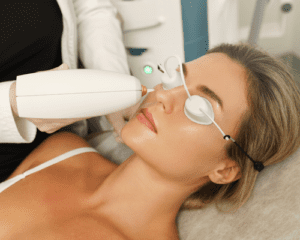
Natural Remedies for Rosacea:
There are a number of natural options for people with rosacea, including changes in diet and skincare. Discussing with a dermatologist the best option based on your needs is recommended. Natural remedies can be used to help reduce the symptoms of rosacea, but these remedies may not be enough to completely cure it, especially in severe cases.
Take time out to lower your stress levels through meditation or even reading a book. We recommend combining a relaxation method with your skincare routine, for example meditating in a warm bath followed by applying the Multi-Purpose Ointment to your body and face. the ointment is extremely hydrating and contains soothing ingredients like vitamin E and organic beeswax that help to calm rosacea.
Some natural remedies for rosacea include taking supplements like omega-3 fatty acids or vitamin D3. You can also try eating more foods rich in antioxidants like blueberries or strawberries to help reduce inflammation in the body. The rosacea diet has improved the symptoms of many people with mild rosacea. This is a non-invasive treatment, but it is not a one-size-fits-all type of treatment.

What Triggers a Rosacea Flare-up?
Individuals with rosacea have an increased vulnerability to certain triggers that lead to the development of redness and flushing. The condition is chronic and progressive for most people.
The symptoms of rosacea can be triggered by certain types of food and lifestyle choices. When people with rosacea come into contact with a trigger, they may experience a flare-up of their symptoms.
Common Rosacea Triggers:
- Spicy foods and drinks
- Coffee
- Red wine
- Dairy products like milk and cheese
- Too much Stress
- Too much sun exposure
- Hormonal changes.
- Smoking tobacco
- Certain medications
- Alcohol consumption
- Infection and inflammation somewhere in the body

How To Prevent & Manage Rosacea
Rosacea is not a skin disease, but rather a condition that causes redness and pimples on the face. It is more common in people with fair skin, but it can happen to anyone who has sensitive skin or a family history of rosacea.
Tips for managing your rosacea flare-ups:
- Drink plenty of water and avoid sugary drinks – these will both contribute to an imbalance of bacteria on the face that may cause breakouts.
- Reduce your intake of dairy products – these contain hormones that can cause breakouts in some people with rosacea.
- Avoid wearing makeup if possible – this will reduce the amount of oil on your face and allow any pimples to heal faster without any added concealer or foundation getting into the pores and causing more breakouts.
- Avoid rubbing your eyes – this may be more difficult for people with rosacea since it is an irritating symptom in some cases.
- Get plenty of sleep – this will help your skin to regenerate and repair.

Tips to prevent rosacea flare-ups:
- Avoid alcohol, hot drinks, and spicy foods (these things will increase the amount of blood flow to your face)
- Use a moisturizer with SPF 30 or higher when you go outside
- Avoid the sun (when it is at its strongest)
- Wear sunglasses with UV protection
Rosacea and Gut Health
Rosacea is a chronic skin condition that is characterized by redness in the face. The root cause of rosacea is still unknown, but recent studies have shown that changes in gut bacteria may be a contributing factor. Gut health plays a significant role in how we experience rosacea symptoms and vice versa. People with rosacea are more likely to have intestinal inflammation and intestinal permeability.
Gut health can determine how your skin will look. The microbiome is made up of bacteria that live in our guts, which helps to regulate inflammation, immune function, and digestion. When we have a healthy microbiome, it can make our skin look better because it helps to reduce inflammation and boost immunity.
The gut microbiome and its interactions with the immune system are now being studied as potential contributors to rosacea. The microbes found in the gut are constantly interacting with the immune system and can influence how it functions.
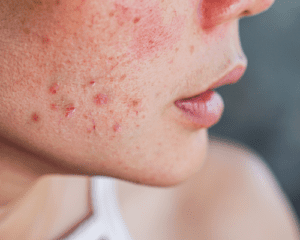
When to See a Doctor for Rosacea
Most people with rosacea have mild cases and live a fulfilling life without any problems or discomfort. If you have more severe cases, you may want to see your doctor for treatment options that are more effective than natural remedies. If you are experiencing pain and ongoing discomfort you should seek treatment right away.
Diagnosing Rosacea
Rosacea is a skin condition that affects the face and it can be difficult to diagnose. There are many other skin conditions that are associated with rosacea, and some of them may be more common than you think.
The most common method for diagnosing rosacea is by a dermatologist examining the appearance of the skin on your face. Rosacea is often misdiagnosed as acne or another skin condition because it shares a lot of the same symptoms with other conditions such as acne vulgaris or seborrheic dermatitis. It can also be difficult to diagnose because there is no blood test for rosacea.
There is no single food, medication, or lifestyle habit that will cure rosacea for everyone. It is important to remember that what works for some people may not work for others. There are many treatment options available and lifestyle changes to improve skin health. Staying positive, educating yourself, and taking a holistic approach to treatment will give you the best result.
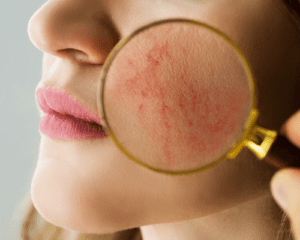

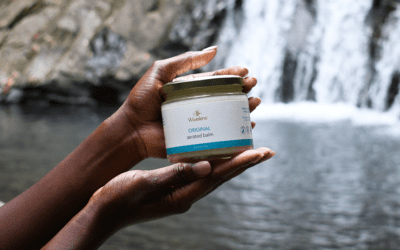


0 Comments